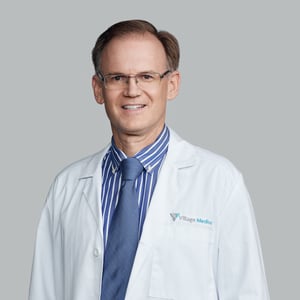A Trusting Doctor Relationship Supports COPD Care
Introducing our new blog, Journey to Well, and what you can expect to learn from it.
Over 70 million Americans have a personal connection to Chronic Obstructive Pulmonary Disease (COPD). Not only is it the 6th leading cause of death in the United States, claiming 150,000 lives each year, it is a condition that is almost always preventable and treatable. The biggest challenge is that many people with COPD don’t know they have it.
“Patients who are living with COPD struggle with ongoing discomfort, breathlessness, and chronic coughs. Through comprehensive primary care, we can help improve their quality of life,” said Dr. Troy Fiesinger, primary care doctor in Sugar Land, Texas.
That is why it is so important to speak with your primary care provider (PCP) about any breathing problems you are having.
Understanding COPD
“I tell my patients with COPD that their lungs don’t work the way they should, but it is almost always manageable,” said Dr. Fiesinger. “Patients often cough a lot because their air tubes (bronchial tubes) are smaller than they should be, so it’s harder for them to clear phlegm out.”
COPD is a chronic disease that often develops very slowly over time, and despite the symptoms, it can be difficult to diagnose the condition, especially early on. In fact, most people with COPD don’t know it. Because of this, patients often get accustomed to their symptoms and get used to feeling bad or having difficulty breathing.
Dr. Fiesinger explains that an important part of diagnosing COPD is listening to the patient and connecting how they are feeling with what is actually going on in their lungs. That’s why it is important for patients to see their PCP regularly, not only to monitor their lung function but to have open and honest conversations about what they are experiencing daily.
Identifying COPD
COPD develops slowly and symptoms usually worsen over time and can be different for each person. Symptoms also tend to vary from day to day, with some days being worse than others. Common symptoms of COPD include:
- Shortness of breath, especially while doing everyday activities
- A frequent cough with or without mucus
- Wheezing (a whistling sound when you breathe in or out)
- Chest tightness
Some of these symptoms are like those related to other conditions, such as heart problems, obesity, asthma, and other chronic diseases. These are called comorbidities, which means there is more than one disease or condition within your body at the same time.
“Comorbidities are important because they help us understand and explain how different conditions might affect your physical and mental health, both together and separately,” explains Dr. Fiesinger. “If you have other symptoms, even if you think they are not related to COPD, be sure to tell your doctor.”
Treating & Managing Your COPD
While COPD is a complex condition and has no current cure, there are many simple steps you can take to manage it and live life better. These include:
- Practicing breathing techniques
- Staying up to date on vaccines
- Making exercise and healthy eating a habit
- Avoiding smoke and air pollution
- Sticking to regular visits with your primary care provider
“When patients leave my practice, I want them to understand that they are not powerless when managing their COPD,” said Dr. Fiesinger. “The five concrete steps above will help them breathe better and get more enjoyment out of life.”
Your Village Medical care team will work with you to figure out which medications, devices and lifestyle changes are right for you.
Help Us Find the “Missing Millions”
According to the National Heart, Lung, and Blood Institute, there are 15 million American adults, the “missing millions,” with undiagnosed COPD. By providing high-quality primary care, we can help patients get ahead of COPD and breathe better. In partnership with the COPD Foundation, we will continue to identify patients with undiagnosed COPD and connect them to treatments to help them breathe better and live healthier lives.
To identify, manage and treat a complex chronic illness like COPD, having a trusting doctor-patient relationship is essential. Together, we can achieve outcomes for your health that you didn’t think possible before. Make an appointment with us today and let us help you take control of your health and well-being.
